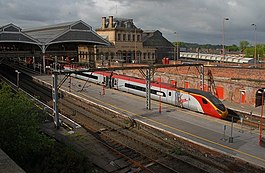Preston railway station
| Preston |
|
|---|---|

The north end of platforms 7 to 4 (left-to-right). The ticket office is centre top.
|
|
| Location | |
| Place | Preston |
| Local authority | City of Preston |
| Coordinates | 53°45′22″N 2°42′26″W / 53.7560°N 2.7072°WCoordinates: 53°45′22″N 2°42′26″W / 53.7560°N 2.7072°W |
| Grid reference | SD534290 |
| Operations | |
| Station code | PRE |
| Managed by | Virgin Trains |
| Number of platforms | 9 |
| DfT category | B |
| Live arrivals/departures, station information and onward connections from National Rail Enquiries |
|
| Annual rail passenger usage* | |
| 2011/12 |
|
| 2012/13 |
|
| 2013/14 |
|
| 2014/15 |
|
| 2015/16 |
|
| History | |
| 31 October 1838 | Opened |
| 2 September 1850 | East Lancashire platforms added |
| July 1880 | Rebuilt |
| 1903 | New platforms added to west side |
| 1913 | New platforms added to east side |
| 1972 | East Lancashire platforms closed |
| National Rail – UK railway stations | |
| * Annual estimated passenger usage based on sales of tickets in stated financial year(s) which end or originate at Preston from Office of Rail and Road statistics. Methodology may vary year on year. | |
|
|
|
Preston railway station serves the city of Preston in Lancashire, England, and is a major station on the West Coast Main Line, and is the notional half-way point on the WCML between London Euston and Glasgow Central 194 miles from Glasgow Central and 206 from London Euston although the actual half-way point is at Leyland, approximately 6 miles south. It is served by Northern, Virgin Trains, and TransPennine Express services, plus Caledonian Sleeper overnight services between London and Scotland.
A station was first opened on this site by the North Union Railway in 1838. It was extended in 1850 with new platforms under the separate management of the East Lancashire Railway, and by 1863, London–Scotland trains stopped here to allow passengers to eat in the station dining room. The current station was built 1880 and extended in 1903 and 1913, when it had fifteen platforms. A free buffet for servicemen was provided during both World Wars. The "East Lancashire" platforms were demolished in the 1970s as connecting lines closed. Only eight platforms remain in regular use today.
As well as intercity trains to London, Birmingham, Manchester, Glasgow and Edinburgh, the station is served by local trains to most parts of Lancashire, and parts of Cumbria, Greater Manchester, Merseyside and Yorkshire.
...
Wikipedia
